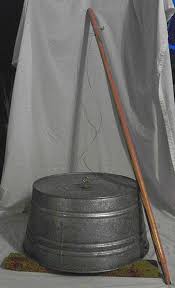 Traditional Washtub Bass |
 Playing it |
 A serious hybrid |
A Tunable Washtub Bass
A washtub bass is (usually) a one-stringed instrument that makes a noise low enough and loud enough to provide a bass accompaniment to music. The resonating chamber of the traditional washtub bass is usually crudely made from a galvanized tub (or, more recently, plastic buckets). But going beyond this, there are infinite variations in materials, form, and craftsmanship. Probably the best place to get a taste of this is The Washtub Bass Page.
The advantage of a washtub bass -- Traditional American or European folk music, particularly when used for dancing, is tremendously enhanced by being supported by a bass line. But standup basses are hard to come by and not easy to play, and even electric basses require serious learning. The virtue of a washtub bass is that anyone with a decent sense of rhythm can use it to provide a serviceable bass line. I've even grabbed people from an audience to do it, and almost never been disappointed.
Traditional washtub bass -- The traditional washtub bass consists of a galvanized tub, a wooden pole (broom handle, hoe handle, ash branch, etc.) and a piece of cord. The tub is upside down. The cord is firmly attached to one end of the pole and threaded through a hole in the center of the tub's bottom and retained there by either tying a knot in the cord or tying it around something else to keep it from pulling out of the hole. The other end of the pole is usually notched, so that when it is rested on the bottom rim of the tub, it doesn't slip off. One hand holds the pole near its top, the other plucks the string. Variations in pitch are achieved by changing the tension on the string by a harder or softer pull on the top of the pole.
 Traditional Washtub Bass |
 Playing it |
 A serious hybrid |
The "wrong idea" -- However, when I was working at Folklore Village Farm back in the early 70's, I didn't know any of this. So when someone told me our small folk band of farm kids should have washtub bass, I knew about a stick and a cord and a washtub, but I pictured something that would be played like a standup bass. That is, you would control the pitch by the length of the string being vibrated. If you're right handed, you'd pinch the string at the desired point with your left hand and pluck it with your right hand about halfway between the pinch point and the tub. (I found plucking was best done by pinching the string between the thumb and first joint of the index finger and then pulling it and letting go, but I've seen people just whack at the string with their hand. Whatever floats your tub...)
The immovable pole -- So I bolted a rake handle to the tub, inadvertantly violating the basic principle of the traditional washtub. I drilled a hole through the middle of the tub's bottom, knotted one end of a piece of clothesline (later window sash cord), and put it through the hole in the tub from the inside. I then ran the other end through a hole I'd drilled through the pole near its top. By squeezing the top of the pole toward the tub and then knotting the end of the rope up against the pole, enough tension was created to play the clothesline.
PLUNK PLUNK vs. melodic participation -- This worked fairly well, but for those of us who wanted to join in the music that was playing -- really participate in the melodic sound instead of just random PLUNK PLUNKs -- it was hard to get into the right key. Given the pinch-off principle of the instrument, it's theoretically possible to play in any key, but the further down the cord you pinch, the less the volume you tend to get out of it. So if the cord works well for a tune played in the key of "D", but the tune being played is in "G", you end up playing down in the lower part of the cord and not getting much sound.
Tunability -- So instead of running the cord through the hole near the top of the pole, I put an eye-bolt through the hole, to which the cord could be attached. This became in effect a tuning peg like on a standup base -- turn the eye to tighten or loosen the cord. It worked wonderfully. The only remaining development was to replace the cord with a G-string from a standup base, which not only sounded better, but was a lot less harsh on the plucking fingers.
So here are some pictures of a tub I've used for maybe 35 years.
 The Bass |
 A friend who's never played turns out (as is often the case) to be a natural |
Details At The Tub (lower) End
The metal handles on a tub can set up an unpleasant metallic rattle during playing. Originally the tub's handles were taped down with duct tape. But tape has a limited lifetime, and eventually the critical decision was made to perform a handle-ectomy.
 Pole/Tub Bolts (outside tub) |
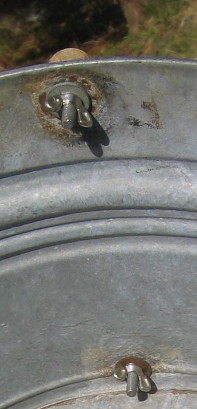 Pole/Tub Bolts (inside tub) |
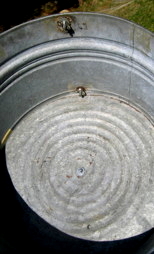 Bolts & String Bottom (inside tub) |
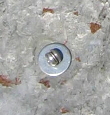 String Bottom (inside tub) |
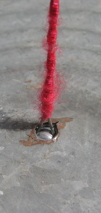 String Bottom (outside tub) |
Details At The Tuning (upper) End
The 1/4"x20 eye bolt is the tuning peg. To try to maintain a stable threaded "cylinder" inside the pole, a hex nut is used on the "inner" end and a reversed wing nut on the "outer" end. The wing nut's wings are inset in a carved groove to keep it from turning, and the hex nut is then tightened into an inset depression. Ideally, the hex nut would then be stabilized by a filler such as plastic wood or epoxy that would stick to the wood and prevent rotation; but it seems to have worked without that. The eye-bolt then turns within this two-ended "cylinder" to adjust the string tension. In order to lock the eye-bolt when the desired string tension has been achieved, a second wing nut is used as a lock-nut against the first wing nut.
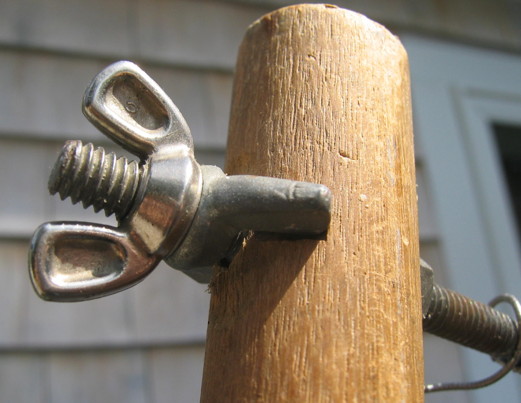 "Cylinder" and Locking Wing Nuts |
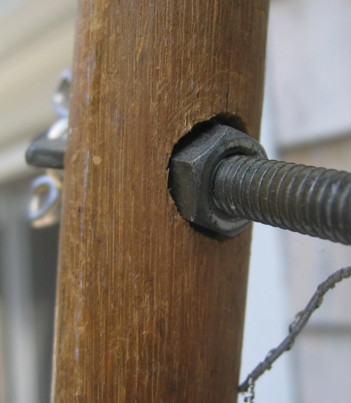 "Cylinder" Hex Nut |
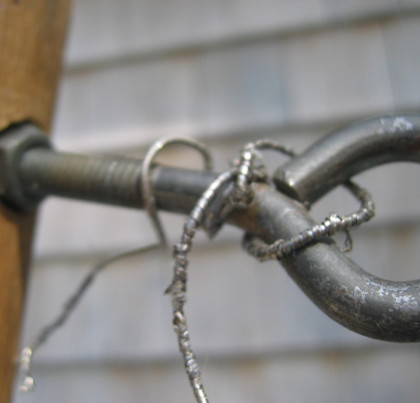 String Wrapped Through and Around Eye-Bolt |